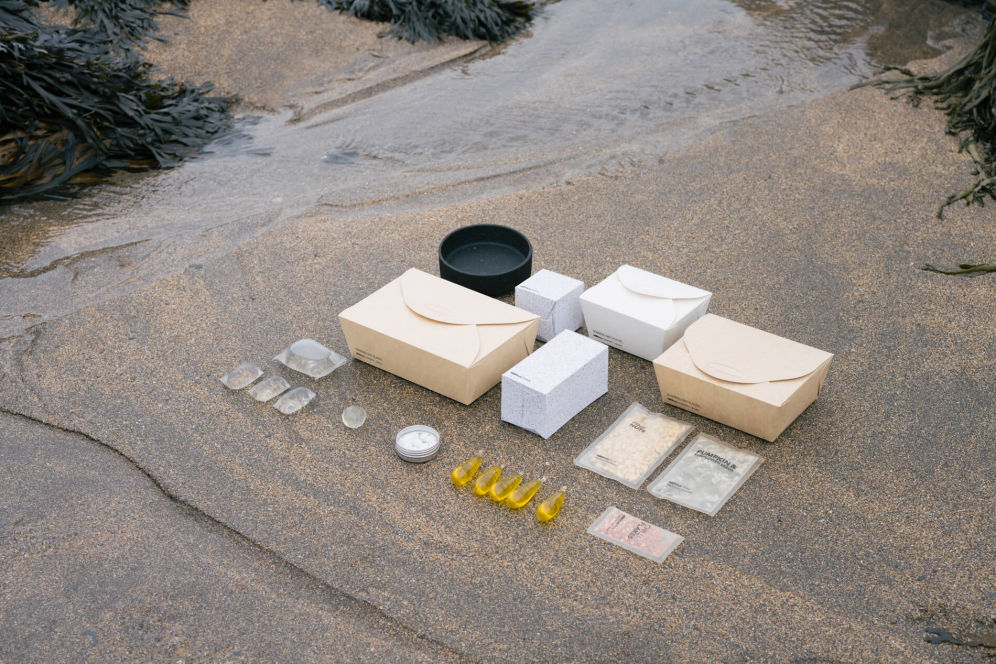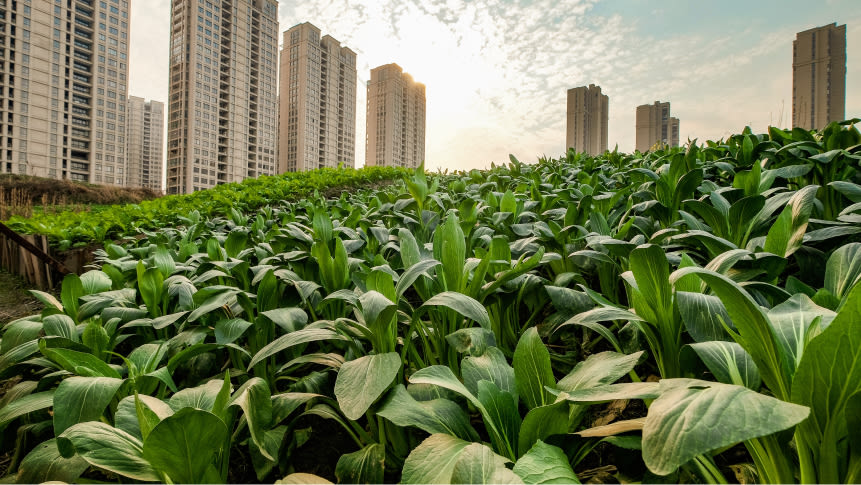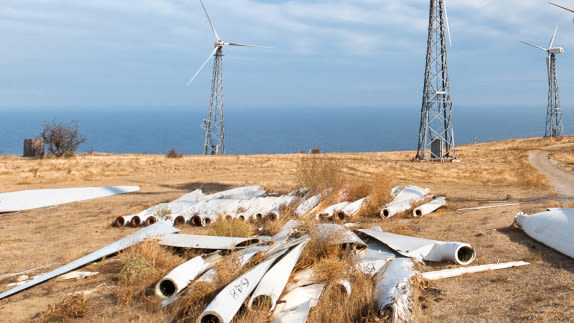Big problems require big solutions. Climate change, its link to other global challenges such as pollution and biodiversity loss, and the solutions we need to muster quickly, are about to be in the spotlight at COP28 in Dubai. The effects of every 0.1 degree temperature increase are becoming more obvious and visible with each year. In parallel, the need for systems transformation, such as those that spring from circular economy principles, is becoming ever more important.
By Emma Elobeid, Senior Editor, Ellen MacArthur Foundation, Ella Hedley, Project Manager, Startups, Ellen MacArthur Foundation, and Miranda Schnitger, Climate Lead, Ellen MacArthur Foundation
As world leaders meet in Dubai, it is important that we broaden our perspective of what a climate solution is to ensure that discussions and outcomes of this vital global gathering are not siloed.
A lot of the time, when people think about ‘climate solutions’ they think along two tracks – the transition to renewable energyrenewable energyEnergy derived from resources that are not depleted on timescales relevant to the economy, i.e. not geological timescales., and carbon dioxide removal (CDR) / carbon capture and storage (CCS) tech. In the main, large scale climate solutions are imagined as swathes of solar panels, roads full of electric vehicles (EVs), and futuristic-looking apparatus that suck carbon from the sky and sink it deep underground. Funding – from innovation funds, grants, venture capital, and private market equity – often follows suit.
It is no surprise that the energy transition attracts such attention — both in terms of headlines and financing. Burning fossil fuels to power the economy represents 55% of global greenhouse gas (GHG) emissions. Switching to renewables is vital to meeting climate goals. But emissions – 45% of them – also arise from how we design, make, and use products and services, including energy assets such as EV batteries, wind turbines, and solar panels. The extractive and wasteful way of operating in our current linear economylinear economyAn economy in which finite resources are extracted to make products that are used - generally not to their full potential - and then thrown away ('take-make-waste'). results in emissions from design to discard: there are emissions from industrial processes, emissions from deforestation and land use change, and emissions from landfill and incineration. In this linear economic model, everything around us has an associated climate impact – from transport to toasters and buildings to baked goods. To tackle these global GHG emissions we need additional solutions that can complement the energy transition.
Circular economy actions can be climate actions. By redesigning how products and services are produced and consumed, using circular economycircular economyA systems solution framework that tackles global challenges like climate change, biodiversity loss, waste, and pollution. It is based on three principles, driven by design: eliminate waste and pollution, circulate products and materials (at their highest value), and regenerate nature. principles, we can scale the positive impact we can have on the climate, and other planetary challenges such as biodiversity loss, waste, and pollution.
Think climate solutions? Think circular startups, too
Circular startups are amongst the most exciting examples of climate solutions in action. Big businesses have an important role to play in accelerating the transition to a circular economy. Startups are equally important – their nimble, fast-moving approach can show the way and inspire action. Unlike more established businesses, startups can start out with a circular economy mindset and model, rather than needing to transition from an existing linear one. As such, they are free to come up with new ideas to old problems from the get go. They are solutions-driven by their very nature, with the cultural agility and organisational ability to challenge the status quo without worrying about upsetting legacy structures or shareholders.
Putting startups in the spotlight can help incubate circular economy innovation and seed solutions alongside big, as well as collective, business-led actions to shift the system from linear to circular. At the same time, big businesses have a vital role to play to help support and scale startups in their mutual pursuit of an economic model that operates within planetary boundaries. To accelerate the transition to a circular economy, we not only need big business and start-up action, but we need both working together.
From food to fashion, circular economy startups are starting to hit the mainstream
As evidenced by the strong circular economy presence in this year’s Earthshot Prize winners and finalists – particularly in the ‘Fix our climate’ and ‘Build a waste-free world’ categories – appetite and awareness for circular economy climate solutions is growing.
The Earthshot Prize is just one example of a burgeoning climate solutions space in which thousands of innovators and entrepreneurs are seeing the economic and environmental potential in the circular economy. In recent years, circular startups have begun to increase in value and visibility. The Ellen MacArthur Foundation’s Circular Startup Index – a public database of startups that demonstrate one or more of the three principles of a circular economy – has a tally of 750 and counting. This increasing number of startups are helping to put circular economy business models firmly in the mainstream. Since 2020, more than ten circular startups, from across sectors, have emerged as “unicorns”.
First up, fashion. If the industry doesn’t transform, it will account for over a quarter of global carbon emissions by 2050, and additional biodiversity and pollution impacts: reimagining clothing design, production, and utilisation is essential. Fashion startups are core to redressing this balance. Headquartered in Vilnius, Lithuania, peer-to-peer marketplace for secondhand fashion Vinted became the country’s first ever unicorn, most recently valued at €3.5 billion, and is currently working with Morgan Stanley towards a potential IPO. According to its 2023 Climate Impact Report, the total saved carbon emissions by the Vinted marketplace in 2021 was 453 kilotonnes of CO2e. Similarly, Paris-based online global peer-to-peer resale platform Vestiaire Collective – shortlisted for the Circular Economy Award in the CNMI Sustainable Fashion Awards 2022 – is said to be worth $1.7 billion. The 2023 Vestiaire Collective Impact Report details a combined 90% environmental impact saving across GHG emissions, air and water pollution, freshwater consumption, land use, and waste. As circular economy models move into mainstream spaces, rethinking linear performance indicators such as optimising for sales-volumes and inventory turnover to the detriment of systems benefits is essential.
Start-ups with circular business models are also taking flight in the consumer electronics space: at the beginning of 2022, France’s most valuable startup, BackMarket, hit a valuation of $5.7 billion. Addressing one of the fastest growing solid waste streams in the world, BackMarket provides a platform for the sale of refurbished devices – from smartphones and audio equipment to laptops and games consoles. On average, BackMarket reports that its refurbished smartphone uses 91.3% fewer raw materials, 86.4% less water, and generates 91.6% fewer carbon emissions than a brand new option, drastically reducing the pressure placed on planetary boundaries.
And look at plastics: for all the attention garnered by AI-engineered enzyme-eating innovation, we also need to urgently prioritise more upstream circular economy innovations that tackle the emissions from the plastics sector. Valued in 2021 at $2 billion, Apeel – whose celebrity supporters include Oprah Winfrey and Katy Perry – are addressing both single-use plastic and global food waste in one by coating fresh produce with a layer of edible, plant-based layer that allows fruit and vegetables to stay fresh two to three times longer, in some cases eliminating the need for plastic packaging. In 2022, Apeel reported a saving of 7k metric tons of CO2e GHG emissions from avoided food waste.
As the circular startup landscape grows, so too does the level of their circular economy ambition
While circular economy climate solutions have not always – to date – been fully represented in the public and popular imagination, each step forward helps to reinforce the climate connection and enable bigger and bolder impact.
…pushing circular economy understanding upstream
Very early movers in a systems transition often can only go so far – they can get to being circular-ish and then need the rest of the system to move with them. As circular economy approaches become more comfortable, it can increase appetite and ambition for other lesser-known circular economy business models. Increasingly, we are seeing circular startups pushing well beyond entry-level ideas like recycling or designing from waste into deeper, more upstream – and therefore more impactful at source – circular solutions.
RepairRepairOperation by which a faulty or broken product or component is returned back to a usable state to fulfil its intended use., to enable reusereuseThe repeated use of a product or component for its intended purpose without significant modification., is a core component of a circular economy: keeping products and materials in use for as long as possible can drastically reduce production-related emissions and pollution impacts, and help ease pressure on planetary boundaries. Circular startups like Open Funk are leaning into longevity over obsolescence, helping to redesign everyday household products in ways that keep them in use on our countertops and out of landfill. Their ‘re:Mix’ customisable kitchen blender is being designed to enable repair and is compatible with any glass jar - two different elements that enable reuse. Their repair model reaps further climate benefits by designing products using modular parts that ease the process of DIY at-home repair, and enabling reverse logisticsreverse logisticsSupply chains dedicated to the reverse flow of products and materials for the purpose of maintenance, repair, reuse, refurbishment, remanufacture, recycling, or regenerating natural systems.. The total estimated impact of Open Funk's prolonged product lifetime in GHG reduction terms is 12 tonnes of CO2e per year.

Credit: OpenFunk

Unlocking the reuse revolution is key to scaling the climate solution potential of a circular economy. Rheaply’s resource exchange platform allows companies, organisations, and institutions to keep in use the products and materials held in their own physical assets by selling them on, and to procure items from the surplus stock of others. Combining inventory management innovation with digital B2B sharingsharingThe use of a product by multiple users. It is a practice that retains the highest value of a product by extending its use period. software to keep furniture, equipment, and internal infrastructure in use for as long as possible, its technology-enabled circular model doesn’t just save on purchasing costs or save valuable items and materials from ending up in landfill but, in doing so, brings significant environmental savings. To date, Rheaply reports more than 800,000 kg CO2e in avoided carbon emissions vs. new product purchases.
In addition to circular business models which keep materials and products in use for longer, circular startups are also innovating to design out waste. Deep Form is a circular startup that is innovating to change the shape of the automotive industry by changing how steel sheets are shaped for production. In a traditional, linear, manufacturing environment, steel shapes are cut from large sheets, often resulting in a significant volume of material waste and therefore excess emissions. Instead, Deep Form designs press tools differently so that shapes can be made from smaller sheets, reducing material burden, costs, scrap rates, and – ultimately – emissions.
…using technology to increase impact
While climate tech should not be considered a silver bullet solution to climate change, pollution, and biodiversity loss, technology can be an enabler of the circular economy which addresses all three planetary crises at source. The digital circular economy market was recently projected to be worth $6.7 billion by 2028, presenting a further investment opportunity.
Some circular startups are embracing artificial intelligence (AI) to help them achieve their climate solution ambitions. Winnow, for example, has been developing AI tools to address one the world’s most pressing climate challenges: food waste. The food system as a whole accounts for a mighty third of global greenhouse gas emissions and within this, half spring from food loss and waste that occurs right across the food supply chain from producer to consumer. This also includes the amount of food waste produced in the catering and restaurant industry. Using technology akin to the intelligent cameras found in driverless cars, Winnow’s AI-enabled waste measurement and tracking tools help the hospitality industry to reduce food costs, cut associated emissions (carbon dioxide and methane, the latter of which possesses 80 times more warming potential in the short term), and build organisational resilience to the rising food prices associated with climate change. Clients span over 70 countries and include hospitality giants such as IKEA, Hilton, Marriott, and more, reaffirming the importance of support from big business in order to scale.

Credit: Winnow

Technology is also being applied by circular startups to the built environment, another sector that has a high global emissions footprint. By reducing demand for key building materials, such as steel, aluminium, cement, and plastic, a circular economy could reduce global CO2 emissions from building materials by 38% in 2050, increase the sector’s resilience to supply chain disruptions, and protect against price volatility of raw materials. In this space, Concular works to create digital copies of new and existing buildings. These material passports enable the reuse and recycling of construction materials at the end of the building’s lifecycle. More broadly, Digital Product Passports (DPPs) – which enable material traceability – are increasingly becoming central levers to help businesses track flows of information and ease the transition from linear to circular supply chains, vital to meeting climate targets.
…and remembering regeneration
Circular startups are also beginning to push the scope of their climate solution ambition by championing the circular economy’s third vital principle, the regeneration of nature and natural systems.
The link between climate and nature is increasingly well understood and recognised. To tackle the triple planetary crisis we need to prioritise circular business models and intentionally unearth new value streams that not only replenish what has been lost through a linear approach but actively help strengthen nature’s ability to perform its vital carbon sequestration functions. In this way, a circular economy approach goes beyond using methods such as carbon credits or carbon offsets.
Both Sway and 2022 Earthshot winner Notpla use circular economy principles to tackle the problem of single-use plastic packaging with seaweed. Both replace fossil-fuel derived plastic for biologically derived materials which are not only plant-based, low-impact, and home compostable but have the potential to absorb up to twenty times more CO2 than land forests. These ocean-inspired startups offer an example of how circular innovation can help us not only prevent the worsening of climate impacts but can help us actively contribute to the regeneration of climate-stablising underwater ecosystems. In order to maintainmaintainKeep a product in its existing state of quality, functionally and/or cosmetically, to guard against failure or decline. It is a practice that retains the highest value of a product by extending its use period. delicate ecosystem balance and protect against unintended consequences, seaweed needs to be regeneratively produced, sensitively cultivated, and carefully harvested. Despite these complexities, it is exciting to see an increasing number of circular startups creating new revenue opportunities at the same time as healing natural systems upon which we all rely.
Alongside big business, circular startups alike are increasingly recognising the commercial and climate impact potential of regenerative agriculture on land. Selva Nevada produces and commercialises Colombian food products, ranging from frozen fruit pulps to artisanal ice cream, made from produce from small farmers practising regenerative agroforestry. At the same time, by creating a market demand for agricultural practices with regenerative outcomes, startups like Selva Nevada can also disincentivize deforestation which is driving climate and biodiversity co-damages.

Credit: Notpla

Credit: Sway
In their journey to scale impact, circular startup climate solutions share similar systemic challenges
In many respects, circular startups share the challenges shared by all startups: finding the right talent, getting to market, building brand value, developing customer relationships. For circular startups, progress can feel particularly stymied by the significant and unique challenge of making circular inroads into complex global systems that have been set up for linear success: from regulatory environments and ‘linear lock-in’ mindsets to traditional manufacturing processes and fragile ‘source-make-deliver’ supply chains.
To fully realise their climate solutions potential, circular startups share many other systemic challenges in their quest to go from niche to norm, including:
…access to finance
Finance is vital to help circular economy startups get off the ground and embedded within the wider climate solution space; both from the outset and as they grow in scope and scale. PwC’s State of Climate Tech 2023 report identifies a “funding shortfall” in high-impact climate solutions relating to some of the world’s biggest emissions sources. Earlier in the year, climate tech investment intelligence provider CTVC described this same mismatch between funding flows and positive GHG impact, citing “disproportionate dollars” being directed towards transport and energy deals versus other critical emissions solution gaps in the built environment and industry. Circular economy startups – by addressing the everyday emissions arising from industrial processes, manufacturing, and resource management – sit squarely within this global funding gap.
In places, that gap is starting to close: circular economy financing has grown rapidly across asset classes and sectors in the last few years. More and more investors are starting to recognise the significant economic growth opportunity presented by a circular economy, estimated at 1.8 trillion EUR a year in Europe alone. Over in the US, Closed Loop Partners (CLP) is an investment firm solely centred on accelerating the transition to a circular economy, helping mitigate climate change through circular solutions. This is achieved by supporting circular innovation, managing circular economy investment funds, and developing essential circular economy infrastructure. Since 2014, CLP reports that its investments have kept 4.8 million tons of material in circulation, resulting in 10.1 million tonnes of avoided greenhouse gas emissions.
Not only can circular startups present a significant opportunity for investors to unlock additional GHG savings, but research indicates that the higher the circularity of a company, the lower its risk of defaulting on debt, and the higher the risk-adjusted returns on its stock. Leading Italian banking group Intesa Sanpaolo has committed to financing circular economy businesses – both SMEs and larger companies – in Italy and beyond as a central part of its long-term funding strategy, in addition to supporting the Circular Economy Startup Initiative acceleration programme. Research also shows that there are further social and economic co-benefits of impact investing for a circular economy which can help communities most affected by climate change and ensure a just transition.
…awareness
It is clear that there is money available for climate solutions more broadly. It is also clear that some progress is being made to diversify investment and mobilise financial flows into circular startups. We must now build on that momentum throughout the financial sector and into the wider business and public landscape so that the significant economic and environmental opportunity of circular startups can be achieved further and faster.
Two factors need to be better understood. First, the link between the climate harms caused by our current economy. And second, the climate solutions presented by a circular economy. This public awareness gap, which can be seen in both media narratives and consumer preferences, is also impacting investment. Increasing mass awareness of how a circular economy tackles climate change will help to shift mainstream mindsets and channel more investment towards circular startups. In parallel, circular startups must also be able to effectively articulate – well beyond proof-of-concept – their climate solution to not only investors but suppliers, manufacturers, and retailers.
…data
For that, they need robust data. Because there is no globally harmonised reporting framework, startups draw on a variety of methods to assess climate impact. Getting going is great but it does make it difficult to align and compare emissions saved or sequestered with peers and competitors, be they linear or circular. To give two examples of different approaches adopted: Winnow measures CO2 emissions by comparing AI-assessed food waste reductions with known non-mandatory Environmental Product Declarations (EPD) and emissions values of food production, transportation, and decomposition. Concular uses data from research institutes to calculate CO2 savings in comparison with equivalent building products on a conservative single-item replacement basis (circular product/material vs. newly produced product/material). Without a common approach, both of these innovative methods are independently useful.
However, standardised measurement and transparent reporting at scale is essential to support the transition to a circular economy. From 2024, businesses will need to report on European Sustainability Reporting Standards (ESRS) including ESRS E5 (Resource use and circular economy) to meet the requirements of the Corporate Sustainability Reporting Directive (CSRD). A globally harmonised approach to climate impact measurement would help further level the playing field.
From unicorns to ubiquity: to help circular startups reach their full climate potential and trigger solutions-oriented tipping points, business, policy, and finance need to work together
The multiplicity of challenges faced by circular startups is matched by the multiplicity of climate solutions they can offer – for the benefit of people, business, and the natural world. Each new entrant takes the circular economy startup space a little further away from being a niche climate solution and a little closer towards being a mainstream concept.
However, given the urgency of tackling our triple planetary crisis, a startup-by-startup approach can’t shift the system from linear to circular at the speed or scale required. Business, policy, finance: all need to work together to redesign a system that will support circular economy success. Together they can bring investment and scale, create enabling conditions, and collectively build the necessary knowledge and resources.
When conducted in concert and collaboration and at an accelerated pace, these benefits won’t be exclusively or singularly felt. Just as the increasing intensity of climate change brings environmental and economic co-damages, increasing cross-sector ambition, action, and impact can bring powerful co-benefits.
Supercharging the climate potential of circular startups can have far-reaching and long-lasting positive economic and environmental impact. Each systemic intervention helps to stimulate demand signals, create self-reinforcing loops of positive action, and trigger the system-wide tipping points needed to transition the entire global economy – from startups to super-corporations in every sector – from linear to circular.
Explore the thousands of innovators and entrepreneurs around the world putting the circular economy into practice further in the Circular Startup Index.







